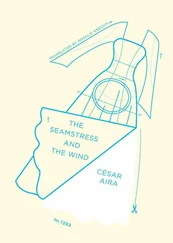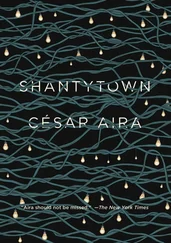Cesar Aira - Ghosts
Здесь есть возможность читать онлайн «Cesar Aira - Ghosts» весь текст электронной книги совершенно бесплатно (целиком полную версию без сокращений). В некоторых случаях можно слушать аудио, скачать через торрент в формате fb2 и присутствует краткое содержание. Город: 978-0-8112-1742-2, Год выпуска: 2009, Издательство: New Directions Publishing, Жанр: Современная проза, на английском языке. Описание произведения, (предисловие) а так же отзывы посетителей доступны на портале библиотеки ЛибКат.
- Название:Ghosts
- Автор:
- Издательство:New Directions Publishing
- Жанр:
- Год:2009
- Город:978-0-8112-1742-2
- ISBN:нет данных
- Рейтинг книги:3 / 5. Голосов: 1
-
Избранное:Добавить в избранное
- Отзывы:
-
Ваша оценка:
- 60
- 1
- 2
- 3
- 4
- 5
Ghosts: краткое содержание, описание и аннотация
Предлагаем к чтению аннотацию, описание, краткое содержание или предисловие (зависит от того, что написал сам автор книги «Ghosts»). Если вы не нашли необходимую информацию о книге — напишите в комментариях, мы постараемся отыскать её.
Ghosts — читать онлайн бесплатно полную книгу (весь текст) целиком
Ниже представлен текст книги, разбитый по страницам. Система сохранения места последней прочитанной страницы, позволяет с удобством читать онлайн бесплатно книгу «Ghosts», без необходимости каждый раз заново искать на чём Вы остановились. Поставьте закладку, и сможете в любой момент перейти на страницу, на которой закончили чтение.
Интервал:
Закладка:
In this sense all the arts have a literary basis, built into their history and their myths. Architecture is no exception. In advanced, or at least sedentary, civilizations, building requires the collaboration of various kinds of tradesmen: bricklayers, carpenters, painters, then electricians, plumbers, glaziers, and so on. In nomadic cultures, dwellings are made by a single person, almost always a woman. Architecture is still symbolic, of course, but its social significations are manifest in the arrangement of dwellings within the camp. The same thing happens in literature: in the composition of some works, the author becomes a whole society, by means of a kind of symbolic condensation, writing with the real or virtual collaboration of all the culture’s specialists, while others works are made by an individual, working alone like the nomadic woman, in which case society is signified by the arrangement of the writer’s books in relation to the books of others, their periodic appearance, and so on.
But in Patri’s dream the architectural analogy was developed a little further. In Africa there is a curious race of pygmies, the Mbutu, nomadic hunters without a chief or social hierarchies. They look after themselves, and everybody else, without dramas. Their communities are relatively small: twenty or thirty families. When they decide to set up camp, they choose a clearing in the jungle and the dwellings are arranged in a “ring,” which, according to the anthropologists, is typical of egalitarian societies. The huts form a circle with an empty center. But anthropologists are dreamers too, sometimes. How could this ring be visible except from a plane? Needless to say, the Mbutu pygmies don’t fly; if they were meant to fly, they would have been born with wings. Also it’s debatable whether or not the center is empty, since it’s occupied by the space that makes it a center. “Whoever speaks in the center is heard by all,” say the anthropologists, alluding involuntarily to dream ventriloquism. The huts are isotopic shells, in which an opening can be made anywhere. The Mbutu make just one: a door, facing the neighbors they like best. Say the lady of the house is cross with her neighbor for some reason or other. No problem; they block up the door and open another one, facing the neighbors on the other side. The researchers who have observed this system fail to draw the logical conclusion: the house of a truly sociable Mbutu would be all doors, and so not a house at all; conversely, a finished and complete construction presupposes hostility.
A contrasting example: the Bushmen. They too are nomadic and their camps are arranged in a “ring”. Except that there is something in the middle of their ring. They place their little houses around a tree; under the tree the chief of the group builds his hut; at the door of the hut the chief lights a fire. What was lacking from the Mbutu camp was not a center, but its symbol. Providing a symbol engages a process of symbolic accumulation: the tree, the chief, the fire…. Why not a rose, a stuffed giraffe, a sunken boat, a mosquito that happened to alight on the earlobe of a Nazi spy, a downpour, or a replica of the Victory of Samothrace?
The little Bushmen are comical, but it’s the same with the extremely serious Zulu, who are formidable hunters and warriors. Those who have had the misfortune of facing them in battle (for example, the son of the Emperor Napoleon III and Eugenia de Montijo) can confirm that they form a semi-circle, “enveloping” the enemy troops before annihilating them. This is a reproduction of the method they use for hunting. And their camps are arranged in the same way: a semi-circle of huts. When the method is transposed from hunting to war, there is a transition from the real to the symbolic, without any loss of practical efficacy. It’s not that one level replaces the other; the levels can coexist, and a Zulu might even try hunting a tasty zebra with a technique tried and tested on the imperial prince. The architecture of the camp, whatever its degree of realization (interpretations and intentions must be taken into account as well as actual huts), constitutes a return to the real, because life is real, and the Zulu have to live, as well as hunting and making war. But they return involuntarily, as it were, without any plan, the way dreams unfold. The centre of the village is a void elegantly furnished with a bloody suction.
The architectural key to the built / unbuilt opposition, which analogies fail to capture, is the flight of time toward space. And dreaming is that flight. (So it wasn’t a pure coincidence that Patri’s dream was about architecture). Except in fables, people sleep in houses. Even if the houses haven’t yet been built. And therein, perhaps, lies the origin, the original cell, of the sedentary life. While habits, whether sedentary or nomadic, are made of time, dreams are time-free. Dreams are pure space, the species arrayed in eternity. That exclusivity is what makes architecture an art. Beyond this point, the timeless mental material of the unbuilt is detached from the field of possibility, ceases to be the personal failure of an architect whose more daring projects stalled for want of financial backing, and becomes absolute. Even the mixture of the built and the unbuilt becomes absolute. The construction at whose summit Patri was sleeping was a real model of that mixture, by virtue of its incomplete state and everything the decorators were still planning to do. It was a step away from the absolute, waiting only for bricks, mortar and metal to expel time from its atomic matrix in a fluid maneuver. That was the purpose of the girl’s dream.
Now if the unbuilt, or the mixture in which it participates, can be considered as a “mental” phenomenon, like dreaming or the general play of intentions, the mind, in turn, can be seen to depend on the phenomenon of the unbuilt, of which architecture is the exemplary manifestation.
There are societies in which the unbuilt dominates almost entirely: for example, among the Australian Aborigines, those “provincial spinsters” in the words of Lévi-Strauss. Instead of building, the Australians concentrate on thinking and dreaming the landscape in which they live, until by multiplying their stories they transform it into a complete and significant “construction.” The process is not as exotic as it seems. It happens every day in the western world: it’s the same as the “mental city,” Joyce’s Dublin, for instance. Which leads one to wonder whether unbuilt architecture might not, in fact, be literature. In urbanized societies, city planning doubles architecture, robbing its symbolic function. If, in nomadic societies, the arrangement of the camp performed a function that was not performed by the construction of houses, that is, symbolizing society, in the planning of large contemporary cities, where the buildings require the convergence of skills and know-how from a great range of social sectors, urban planning repeats a function already satisfactorily performed, and ends up having no function of it own (or rather it symbolizes the policing of society). But perhaps it would be better to say that it leaves a “symbolic vacancy,” an energy unemployed by any current necessity. The Nias come to mind with their twin deities, Lowalani, who represents positive forces, and his enemy, Latura Dano, god of the negative. According to the Nias, the world is layered, made up of nine superposed planes, on the highest of which resides Lowanlani, sleeping with his consort, a nameless goddess (let’s call her Patri), who is a kind of mediator. The planning of the Nia villages “represents” this construction, horizontally of course, the high, for example, corresponding to the right-hand side, and the low to the left, or whatever. Now the condominiums, the skyscrapers that the Nias haven’t built (negating the negation of the unbuilt, as it were), would represent symbolism itself. From which it could be deduced that for every building there is a corresponding non-building. On the same principle, the natives of Madagascar make pretty wooden models of multi-story houses, crammed with little people and animals, which are used as toys. If those models represent anything, it is “the children’s house,” another form of the unbuilt.
Читать дальшеИнтервал:
Закладка:
Похожие книги на «Ghosts»
Представляем Вашему вниманию похожие книги на «Ghosts» списком для выбора. Мы отобрали схожую по названию и смыслу литературу в надежде предоставить читателям больше вариантов отыскать новые, интересные, ещё непрочитанные произведения.
Обсуждение, отзывы о книге «Ghosts» и просто собственные мнения читателей. Оставьте ваши комментарии, напишите, что Вы думаете о произведении, его смысле или главных героях. Укажите что конкретно понравилось, а что нет, и почему Вы так считаете.












